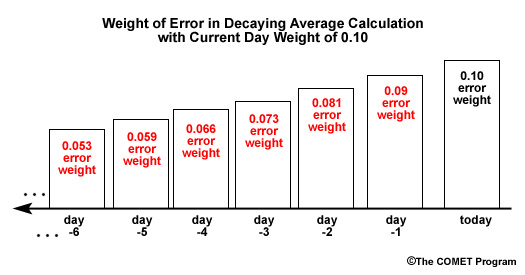Ensembles Lessons
Table of Contents
Bias Correction in Ensembles
What is Bias?
Let's say you throw 100 baseballs, aiming at the same place. You won't likely hit the same spot each time. There may be a flaw in your throw so you hit high and to the right of the target. There will also be errors beyond your control like random variation in the wind, an imperfect ball, or other complications. These are two different kinds of errors. One you can correct, while the other you cannot. The flaw in your throwing style can be corrected with practice and is known as a bias. The errors from random variation in wind and imperfections in the ball are not correctable and are known as random errors. The bias and the random error together constitute the total error.
How Significant is Bias?
In NWP models, both random errors and bias can and do occur on a regular basis. However, under most conditions biases account for only 10-20% of the total error.
In practice, we know that winds weaken with time in NAEFS. Energy is not properly conserved and bias correction can account for the discrepancy. As a result, the bias correction for wind in NAEFS increases with time.
Decaying Average
NCEP uses a "decaying average" method to correct bias. A decaying average gives a greater weight to today's error relative to previous days' errors. This means that older errors will have less influence on the current bias than more current errors do. In the graphic below, the bar heights represent the weight given each day's errors as we go back in time. The most recent day has the most error weight.

NCEP uses the decaying average method to produce bias-corrected data for the NAEFS and NUOPC ensemble forecast systems. The weighting scheme was chosen to give the best overall results over the full forecast domain for each system
Because the GEFS and the Navy Ensemble Forecast System (NEFS) use a single model with initial condition differences to create their ensembles, the bias is calculated for the ensemble mean and then applied to each ensemble member. In the case of the Canadian Ensemble (CEFS), each ensemble member uses a somewhat different configuration of the Canadian Global Environmental Model (GEM) and behaves somewhat differently. So bias is calculated for the individual models and applied to that ensemble member forecast.
Decaying average bias correction from the model forecast results in overall improvement in model scores, thus bias-corrected products usually provide superior guidance. Because bias tends to depend on the weather regime, bias correction works best under stable weather regimes and poorly under shifting regimes.
The best results from bias correction are obtained when the bias error is a large proportion of the total error. In situations where the spread between ensemble members is large, any bias correction will be relatively small. Sound decision-making by the forecaster will have a much more significant effect.